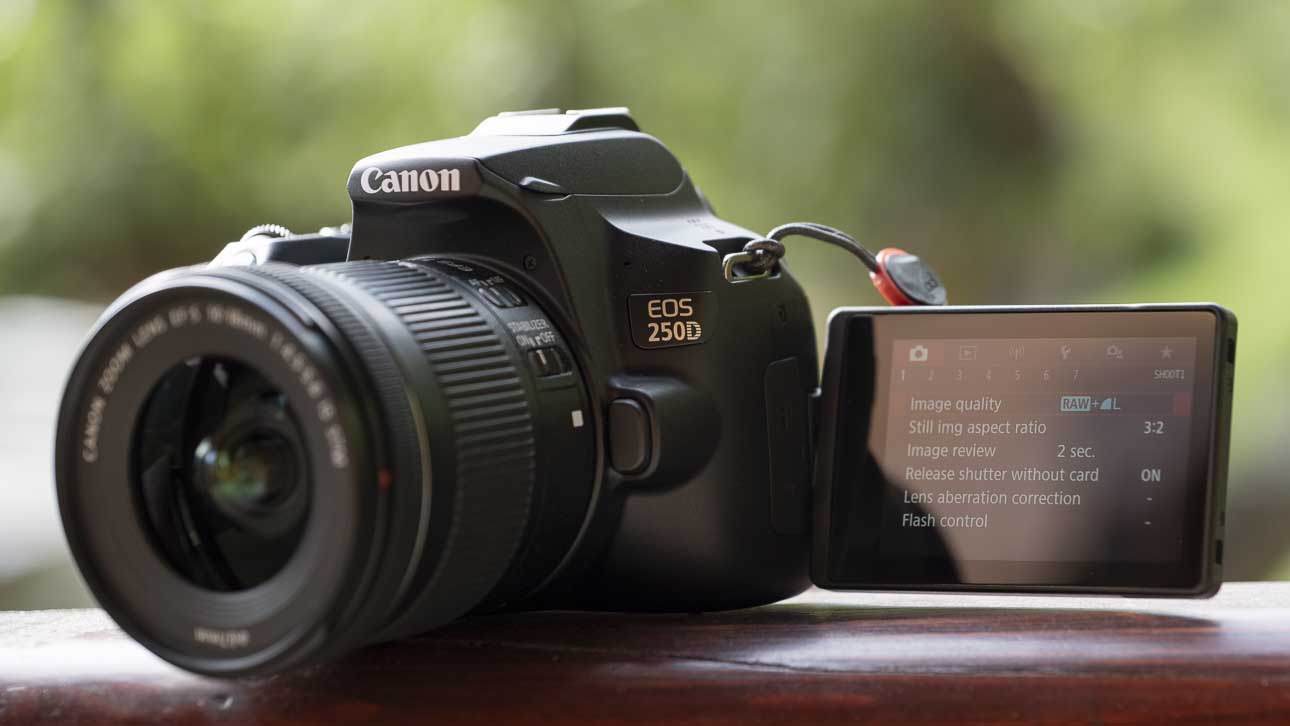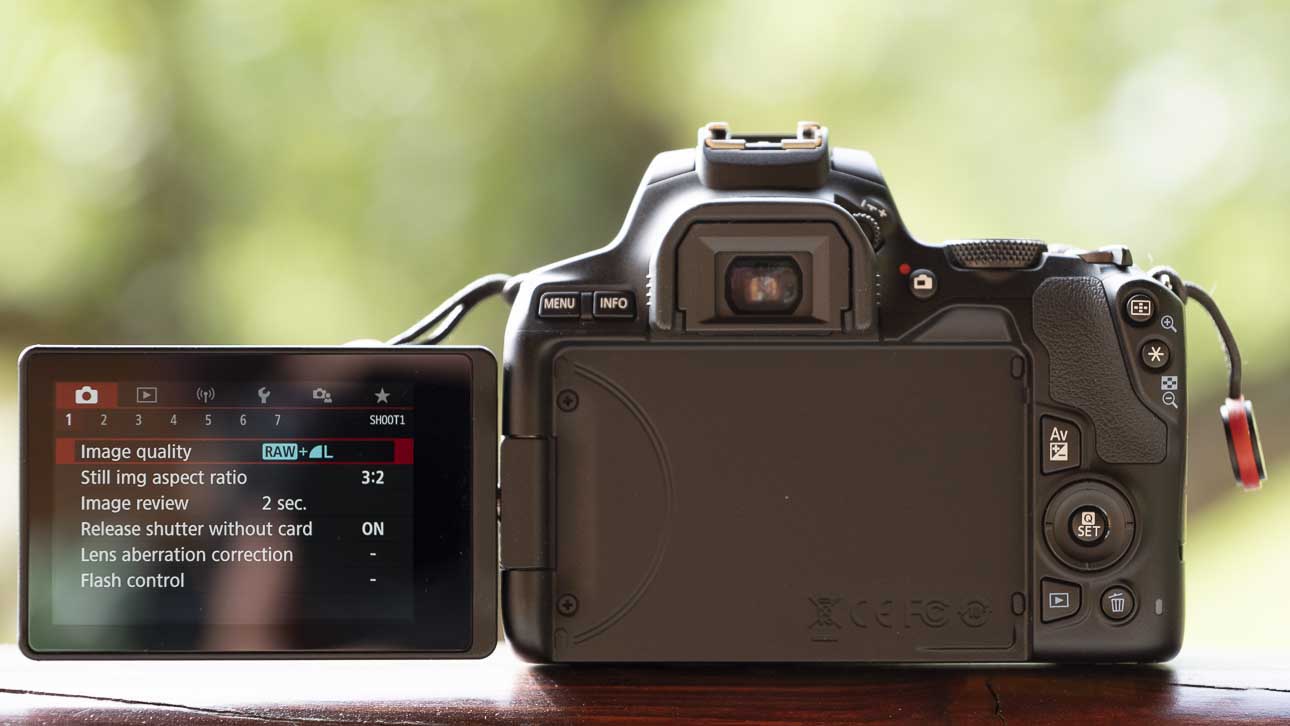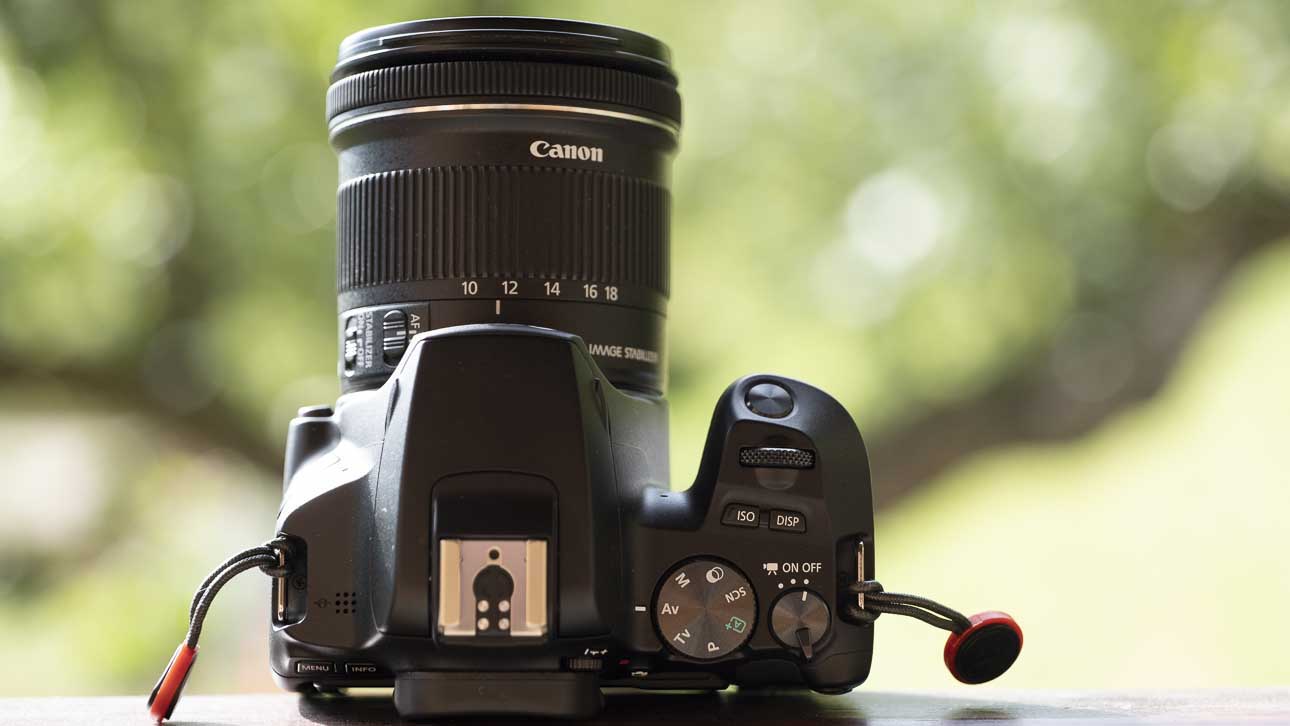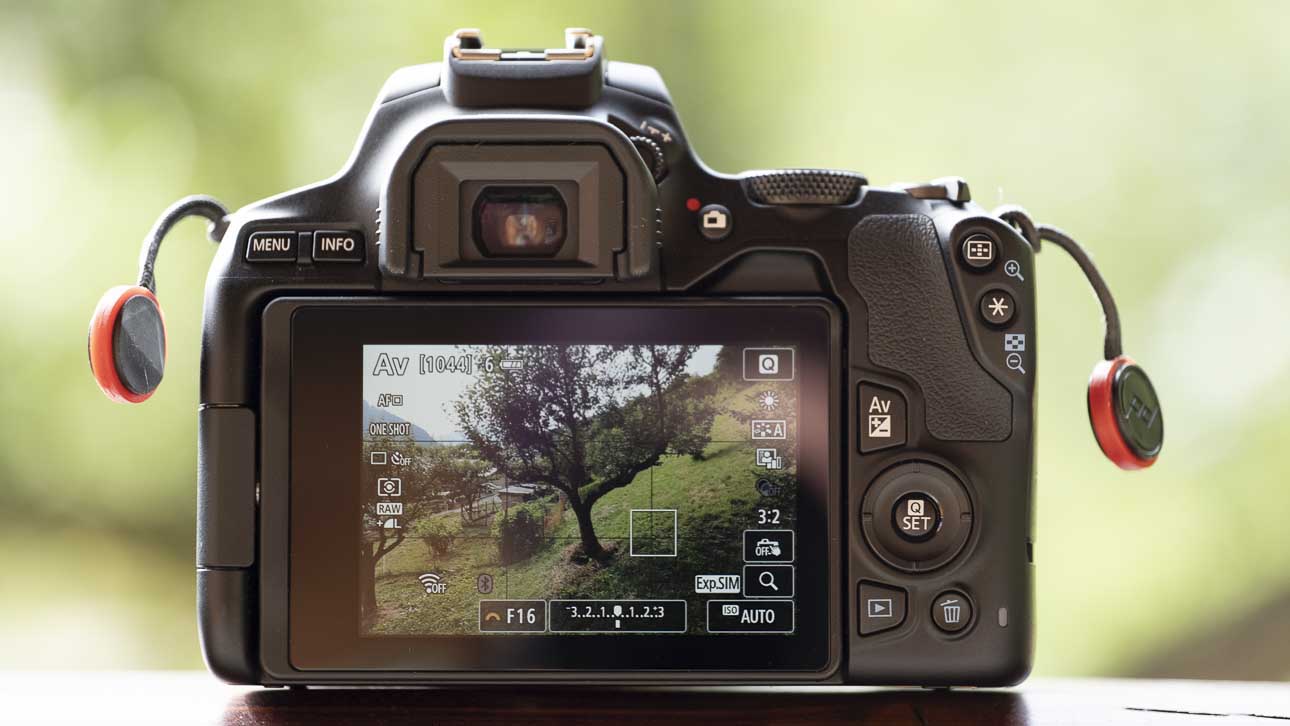Snap Verdict
The Canon EOS 250D, known as the EOS Rebel SL3 and the EOS Kiss X10, is designed for beginner photographers, however, it has a bit more to offer than the Canon EOS 2000D (EOS Rebel T7) and EOS 4000D.
It’s also the smallest DSLR with a moveable screen and the replacement for the Canon EOS 200D / Canon EOS Rebel SL2 / EOS Kiss X9. It has an APS-C format 24.1Mp Dual Pixel CMOS sensor, 4K video technology and a vari-angle touch-screen.
It’s also a capable little camera that can get subjects sharp quickly and captures attractive images with a good level of detail. In fact, it’s the best entry-level DSLRs around at the moment. However, many beginners are better served by a mirrorless camera.
Features
Canon has paired the SL3’s sensor with its Digic 8 processing engine. As well as enabling 4K movies recording, this powers a maximum continuous shooting rate of 5fps (frame per second), 4K time-lapse mode and 4K image grab from movies.
In addition, the standard sensitivity range for stills is ISO 100-25,600, with an expansion setting of ISO 51200. With Full-HD movies, the native range is ISO 100-12, 800 (expandable to ISO 25600). In 4K movie mode, the maximum level is ISO 6,400.
Autofocus
As it’s an SLR, the Canon 250D / SL3 has two autofocus systems. When the optical viewfinder is in use, the camera employs its dedicated AF sensor which has 9 phase-detection points. However, in live view mode, when the image is composed on the main screen, the 250D uses the Dual Pixel CMOS AF System. This has phase detection pixels embedded in the imaging sensor.
Using the screen vastly expands the number of focusing points available for selection. The camera can choose between 143 AF points automatically, but there are 3,975 points available for manual selection. Fortunately, you can select the one you want to use with a tap on the screen.
These AF points cover up to 88% of the width and 100% of the height of the sensor.
Key Features
- Resolution: 24.10Mp
- Sensor: APS-C format Dual Pixel CMOS AF sensor
- Sensitivity range: ISO 100-25,600, expandable to 100-51,200
- Storage: SD/SDHC/SDXC USH-I
- LCD: 3-inch vari-angle touchscreen with 1,040,000 dots
- Viewfinder: Optical
- Connectivity: Wi-Fi, Bluetooth
- Battery: LP-E17 rechargeable Li-ion (supplied)
- Weight: Black/Silver 449g, White 451g
- Dimensions: 122.4 x 92.6 x 69.8mm
Build and Handling
As Canon is aiming the Rebel SL3 / 250D at novice photographers, it’s never going to have the durable build of a pro-level camera. However, it looks and feels much nicer than the Canon EOS 4000D. It’s more refined and a little less entry-level in appearance.
Naturally, Canon has given the camera a fairly modest collection of buttons and dials. For example, there’s only one adjustment dial. As a result, if you select Manual exposure mode via the mode dial, you have to press a button before the adjustment dial can be used to set the aperture. Pressing the same button in aperture or shutter priority mode allows you to set the exposure compensation.
Also, when you’re using the viewfinder to compose images, you have to press a button and then use the navigation pad to select the AF point you want to use. If you take your eye away from the viewfinder, you can tap on the point on the screen after pressing the button.
Of course, if you’re composing images or video on the screen, you can just set the AF point with a tap.
While the control layout is good, when I first started using the 250D / SL3, I kept pressing the AEL button instead of the AF point selection button when looking in the viewfinder. That’s annoying, but after a while the muscle memory develops.
User Interface
There’s a choice of menu and interface style with the Rebel SL3 / 250D. Beginners are most likely to opt for the Guided interface, while more experienced photographers may prefer Canon’s Standard interface. They give the same type of information, but the Guided interface looks friendlier.
Whichever option you select, the menu layout is logical and easy to follow. Helpfully, all the menu items are touch-selectable. The same goes for the Quick Menu, which means you can adjust the camera’s settings very quickly.
Viewfinder and Screen
As the Canon EOS 250D is a DSLR, the viewfinder is optical. That means it shows the image through the lens but none of the camera settings are applied. Consequently, when you adjust the exposure settings, for example, you don’t see a change in the image in the viewfinder.
You have to activate the live view system and compose the image on the 3-inch 1,040,000-dot touchscreen on the back of the camera to preview the image with the camera settings applied.
As the screen is on a vari-angle hinge, it can be tilted and twisted for viewing. This is helpful for all sorts of photography and videography. However, in very bright light, or with fast moving subjects, the viewfinder is a more natural choice.
There are higher-resolution screens available, but the SL3’s still shows a good level of detail and I really appreciate the ability to move it into a good viewing position.
Performance
The SL3 /250D really impressed me when I was shooting downhill biking. I was shooting with the Canon EF-S 18-55mm f4-5.6 IS STM kit lens mounted, yet the camera did a great job of getting the cyclists sharp. What’s more, when I kept the active AF point over them in the viewfinder, the SL3 / 250D kept them in focus most of the time. That’s good going for an entry-level camera with a kit lens. The conditions were bright, which would’ve helped, but I’m happy with the results.
I continued to be impressed with the AF system when I headed into an ice cave. Despite the dark, low contrast conditions, the AF system managed to get my subjects sharp in almost every shot when I used the viewfinder. However, the live view AF system struggled with the low light and I had to use the viewfinder.
Exposure
Another thing that I noticed from the outset with the 250D / SL3 is how reliable the Evaluative metering system is. This is the default option when the viewfinder is in use and it takes a lot in its stride. There were a few occasions when I used the exposure compensation to protect the highlights a little, but in most situations, the camera does a great job of exposing the main subject correctly.
The image sensor provides the data for the exposure in live view mode. Again the camera does a good job, but the live preview means you can be sure of the exposure before you press the shutter release. This meas that the metering system isn’t quite so important, but it’s helpful when it gives a good starting point.
Image Quality
This isn’t the first time that Canon has used an 24Mp APS-C format sensor and it delivers the results I’d expect.
There’s a good level of detail and noise is controlled pretty well. However, I recommend limiting the sensitivity setting to ISO 6400 or lower if you can when light levels fall. Going higher than that results in more visible noise in the raw files and the Jpegs start to get a bit soft.
The SL3 / 250D’s dynamic range is fairly modest. There’s a bit of latitude, but images can become grainy when they’re brightened by more than 2EV or so.
Colour
I used the Canon EOS 250D / EOS Rebel SL3 in a wide range of conditions and in almost every case it’s produced attractive colours. While the auto white balance setting does a good job, I recommend using the Daylight setting in most natural lighting. It tends to deliver vibrant results with slightly warm colour. The results aren’t so warm that they look unnatural, they’re just pleasing to our eyes.
Video
While its great to see 4K video shooting capability in the SL3 / 250D, it’s disappointing that Canon has again made this at the expense of additional cropping. Consequently, when the movie size is set to 3840 x 2160, the framing is cropped by around 1.5x. That’s in addition to the usual crop with an APS-C format sensor.
As a result, the widest point of the 18-55mm kits lens is equivalent to approximately 43mm.
This means you’ll need a wider lens if you want to vlog with the camera at arm’s length. Unless you have unfeasibly long arms, your face will look too large in the frame for most shots.
The crop factor is less of an issue for other types of video recording as you can take a few steps back to get the view you want.
It’s also worth noting that the autofocus system switches to contrast detection instead of phase detection when you switch to 4K mode.
While it’s advisable to connect an external mic via the camera’s 3.5mm port to get the best audio, I found the internal mic does a reasonable job of recording ambient sound – as long as it’s not windy.
Sample Images
Follow the link to browse and download full-resolution images
[FAG id=84350]
Sample Video
This 4K (3840 x 2160) video was shot at 25p on the Canon EOS Rebel SL3 / EOS 250D – handheld.
Verdict
While the Canon EOS Rebel SL3 / EOS 250D is a very nice entry-level DSLR, it would be just a little better if you could switch seamlessly between shooting with the viewfinder and shooting with the screen. However, acheiving that would mean getting rid of the mirror.
With a mirrorless camera, there’s no difference in the camera’s performance whether you shoot using the viewfinder or the screen. Also, it’s a major advantage to beginners to be able to preview the image in the viewfinder with the camera settings applied.
And while the 250D’s AF system available with the viewfinder is better in low light, using the screen gives you more freedom to focus where you like.
However, if you want a DSLR and not a mirrorless camera, the EOS Rebel SL3 / EOS 250D makes a very good choice for beginners and anyone looking for something small. It’s easy to use and produces high quality results.







